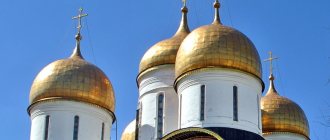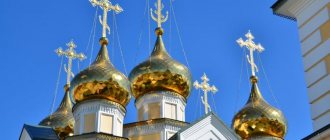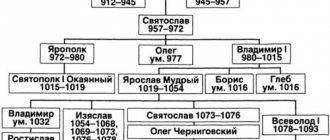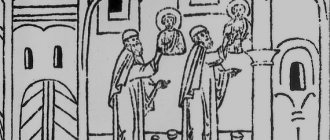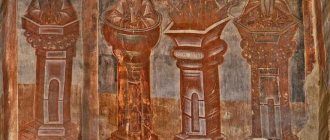Content:
1. What dimensions can the dome have?
2. What types of cladding are there? 3. What types of decorative coverings are there for domes? 4. Manufacturing cost. 5. Production time. 6. How to order the production of a dome. Making a dome is a technologically complex process. The finished product must be of the correct shape.
A dome is a hemispherical structure, where all the lines on top smoothly converge to one point. Onion-shaped structures are more aesthetically pleasing. And this form came to us from ancient Rus', so now it is an integral part of our culture.
When producing domes, it is very important to correctly observe the geometry so that the further cladding process goes smoothly.
Over the course of our entire practice, we have made dozens of domes of various shapes and sizes.
What dimensions can the dome have?
The diameter of the dome can be any; as a rule, it is a dome with a diameter of up to 12 m.
One of the largest domes that we made at the beginning of our career in 1995 was the dome for the Cathedral of Christ the Savior. Its diameter is 36 meters. But this is a unique case for the city, for Russia and for us.
If we do not take into account the Cathedral of Christ the Savior, then we made one of the largest domes for the Church of the Blessed Virgin Mary in Veshnyaki on the street. Ketcherskaya. Its diameter is around 10.4 m.
At the same time, the smallest domes made are 0.5 m, for example, one of these for a chapel in the Zaraisk region.
The significance of the architecture of Orthodox churches
According to the information publication comandir.com, churches in Rus' have long been built taking into account Orthodox symbols, in which everything mattered - the architecture of the structure, the color of the domes, their shape. Each element of an Orthodox church corresponded to church doctrine and carried certain information about Orthodoxy, about who this temple is dedicated to, and what it symbolizes.
The architecture of Orthodox churches in Russia has changed over the years and is distinguished by a variety of styles. In the 15th-17th centuries, Russian wooden architecture with a pointed tent predominated; by the beginning of the 18th century, Baroque stylistic motifs began to be used more and more often. In the 19th century, Byzantine architecture began to dominate in the construction of temples. And only at the beginning of the 20th century the revival of medieval Russian church architecture began.
Currently, it is impossible to single out one predominant architectural direction; each era has left something of its own in the architectural style of Orthodox churches in Russia, but the basic forms of churches have been preserved to this day:
- an eight-pointed star - a symbol of the guiding star of Bethlehem;
- the ark is a symbol of salvation;
- the cross is a symbol of the foundation of the church and salvation;
- circle - a symbol of the eternity of the church.
Sometimes there are mixed styles of temple construction.
What types of cladding are there?
There are several types of decorative cladding for the dome:
- Straight surface
- Oblique checker
- Straight checker
- Flat oblique checker
In fact, there are still different types. They are carried out extremely rarely, but we will be happy to make a special type of cladding according to your project.
Concrete shotcrete technology was used for the dome of the St. Nicholas Church. The dome elements are made entirely of concrete with supporting metal frame parts.
What are the types of decorative coverings for domes?
In our work we use five main types of decorative covering for domes:
- Dome made of galvanized steel with polymer coating. Any standard colors from the RAL catalog.
- Dome lined with stainless steel coated with titanium nitride TiN.
- Copper dome.
- Dome lined with stainless steel plated with 999 gold.
- Copper dome, coated with gold leaf.
Of course, they differ in cost, production time, and appearance. Gold coatings are more expensive, but gold looks the part and gives a characteristic shine and shine in the sun.
It is also possible to assemble a dome from sheets coated with titanium nitride. Titanium nitride is a gold-colored coating that is a couple of shades duller, but also cheaper in cost.
If the budget for making domes is very limited, the first two options are used, which also look decent.
Gilding of domes: revival of roofing traditions
The best material for covering domes is roofing copper
The gilding of temple domes can easily be called a “jewelry” industry, both in the literal and figurative sense of the word. Sergei Viktorovich Kokonin, a master gilder with 20 years of experience, and Sergei Ivanovich Pastukhov, general director of the Golden Domes production association, spoke to the editors of the Krovli magazine about existing gilding technologies.
Since ancient times, the domes of many Russian Orthodox churches have been covered with gold. Before the revolution, “fire gilding” was more often used - using an alloy of gold and mercury. However, working with mercury requires strict adherence to safety measures due to the high toxicity of this metal and poses a great health hazard. For example, when gilding the domes of St. Isaac's Cathedral in 1838-1841. 60 workers died from exposure to mercury vapor.
In Soviet times, the skill of “gilders” was not in demand, since such work was required only during restoration work. Many technological secrets were lost then, and with the beginning of the revival of the Russian Orthodox Church, with a sharp increase in the volume of reconstruction and construction of churches, the shortage of experienced craftsmen became especially noticeable.
Since the early 90s of the 20th century, a material that imitates gilding began to be used for the construction of domes - stainless steel coated with titanium nitride. This solution is significantly cheaper than real gold. At that time, the use of titanium nitride was quite justified due to a lack of funds. It seemed that imitation would completely replace the labor-intensive and expensive gilding technology, but time has shown: “all that glitters is not gold.”
How do we cut the domes?
In the case of large domes, in order to avoid damage to the gilding layer during installation, work is most often carried out on an already installed dome, from scaffolding, and therefore not always in a convenient position
If we talk about the shape, the main difference between the work on the manufacture of domes and conventional roofing work is that it is much more difficult to use seam roofing technology on a spherical surface, especially with subsequent gilding. Therefore, the connection of roofing panels “in a lath” is used, and when covering “in a checker”, a connection “in a hook” is used. It is especially worth noting that the riveting often found on domes is a gross technological error.
As for the color of the roofing, there are certain church canons and traditions, according to which during the construction of Orthodox churches, various colors are used to decorate the domes - blue, green, gold, silver, etc., each of which has its own symbolism. There are also multi-colored domes, but they are rather an exception.
The main material for covering domes is roofing copper, which is known to change its color over time from brown to dark brown, and then acquires an emerald hue. But domes made of “pure” copper, covered with a natural patina, are still rare in Russia. Perhaps the situation will change in the future: German manufacturers are already offering on the market roofing copper with a coating that prevents the formation of patina, as well as patinated emerald-colored copper by chemical treatment of plain copper (artificial aging).
To give the desired color, copper can be coated with gold leaf or painted.
S.I. Pastukhov fully agrees with those who claim that “painting copper is not the best option. But today it is difficult to find a decent material for these purposes that has a blue, green, silver color. The proposed galvanized steel with a polymer coating of various colors does not solve the problem of architectural and artistic decoration of the temple. For blue domes today, stainless steel coated with titanium oxide is used. But the production of such material is very expensive, and the quality leaves much to be desired. The problem of green and silver is also not solved. This is an interesting question for discussion by readers of the Roofs magazine.”
In our age of technological progress, gilding of domes is done either using modern galvanic technology, or the “old-fashioned way” - by applying leaves of gold leaf.
Gold leaf
The word “leaf” comes from the word “susal” - “face”, “front surface”. The final result of the entire cycle of restoration work largely depends on the quality of gold leaf.
“Book” of gold leaf
There are about 30 technological operations for obtaining finished gold leaf, and each of them has its own subtleties that affect the quality of the resulting product. In a simplified form, this can be described as follows. Gold is rolled into a thin strip. The strip is cut into squares, the squares are placed between sheets of special tackle (previously in Rus' they used beef casings *, now - special paper, polymer materials) in a stack containing from 100 to 300 such squares. This entire stack is flattened until each square is a few hundredths of a micron thick.
Gold leaf comes in so-called books, in which sheets of gold are inserted between sheets of paper. Such “books” can contain from 5 to 60 sheets of gold.
Applying gold leaf in the workshop (pictured: S.V. Kokonin)
For gilding domes, heavy gold is used - with a ligature weight of 60 sheets from 2 to 6 g. There is also light gold weighing “a book” of up to 2 g, but it is intended for interior work. S.V. Kokonin, a famous master gilder, warns that such gold cannot be used for gilding domes. You need to pay attention to this.
Domestic manufacturers have always produced gold leaf in the same size - 91.5x91.5 mm. Foreign manufacturers - German and Italian - produce “books” of various sizes. Now their products, due to high demand, are also present in Russia.
In the precious metals market, gold leaf is considered a product. Moreover, the product is not cheap, since it is always 960 standard. Such a high standard is due to the gilding technology - the gold must be very soft. “The use of any additives, even in minimal quantities, leads to loss of plasticity,” says S.V. Kokonin, “gold begins to tear and wrinkle, which affects the quality of work and its rise in price, since in order to eliminate defects in the form of breaks, cracks, and visible mordan (the varnish on which gold is glued), additional amounts of gold have to be used, which increases the consumption of material.”
Gilding technology using gold leaf
A prerequisite when carrying out work on gilding domes with gold leaf is the temperature regime. The temperature should not be lower than +14°C. Therefore, even in the warm season it is necessary to provide a “thermal circuit”. Work is carried out only in calm weather, and better - on scaffolding equipped with wind protection. This requirement is due to the properties of the material - gold leaf sheets are so light that even the slightest breeze can make work impossible.
S.V. Kokonin: There are big problems with training now. There are no special educational institutions, and in existing restoration and art universities only four academic hours are allocated for gilding. So master gilders are “raised” by the masters themselves, passing on their accumulated experience to their students.
Gold deposition technology has several key stages. According to S.V. Kokonin, “first the surface is cleaned and degreased. Then the surface is primed. After the primer has dried, “highlighting” is applied - yellowish-golden paint, which allows you to hide possible minor gold defects on the surface to be coated. When the “backlight” has dried, it is coated with moisture-resistant varnish. After the varnish has dried, they begin to apply mardan - the adhesive base for gold leaf. Only when it dries and acquires the necessary tack is gold applied. Gold is applied to the surface using a “foot” - a special brush made of squirrel hair. If necessary, the gold is cut with a special knife. To avoid damaging the gold, this operation is performed on a special suede pad.”
Goldsmith's tools: a special knife for cutting gold, a suede cushion on which all the preliminary processing of gold takes place, “paws”
In general, the gilder’s tools are not rich: a special knife for cutting gold, a suede pad on which all the preliminary processing of gold takes place, an oiler and a set of various “paws” - fan brushes made of squirrel fur for applying and leveling gold sheets. That's probably all. The main thing is skillful hands.
When restoring the dome, work is done upstairs. In new construction it can be different. If the dome is small, then gilding is done in a workshop or on a specially equipped area near the temple. In the case of large domes, in order to avoid damage to the gilding layer during installation, work is most often carried out on an already installed dome, from scaffolding, and therefore not always in a convenient position.
Electroplating
Electroplating is an electrochemical process in which a layer of gold is formed on the surface of another metal.
A solution of salts of the applied metal, in our case gold, is used as an electrolyte. In this case, a metal plate acts as an anode, and a stainless steel sheet intended for gold plating acts as a cathode. Positively charged gold ions are directed to the cathode and deposited on it, forming a layer of gold with a thickness ranging from fractions of microns to tenths of millimeters.
The thickness, density, and structure of galvanic coatings can vary depending on the composition of the electrolyte and the process conditions—temperature and current density.
The coating process consists of three stages: surface preparation, coating application and post-coating finishing.
To ensure strong adhesion of the coating to the product, it is necessary to thoroughly prepare the surface - grinding, polishing, degreasing, removing oxides. Grinding is carried out mechanically using grinding machines, emery cloths and pastes. Surface degreasing is carried out in organic solvents: alcohol, gasoline, acetone, benzene, trichlorethylene.
After applying the coating, the product is rinsed in distilled water, washed and neutralized in an alkaline solution, the adhesion of the coating is checked and the product is finished.
For clarity, let’s consider the cost of a dome, calculated for a specific temple in three options: • a dome with a diameter of 3 m with a “skirt” and valances coated with titanium nitride - 354,420 rubles; • dome with a “skirt” and valances, lined with roofing material coated with galvanic gold – RUB 1,177,470; • dome with a “skirt” covered with gold leaf and with valances covered with galvanic gold – RUB 1,124,470. Calculations are given in the magazine “Church Builder”, No. 26 / 2010.
Peculiarities
Among the advantages of galvanic gold plating are durability, as well as some features associated with installation. In particular, unlike traditional gilding, roofing sheets gilded by the galvanic method can be installed at any time of the year without the use of wind- and moisture-proof covering tents.
Leveling gold sheets on the surface
However, there are also difficulties. For example, gold-plated stainless steel is difficult to shape into the rounded shapes of domes, resulting in edges. Any deficiency in roofing work on such a dome becomes almost irreparable, which affects the visual perception of the dome. When gilding with gold leaf, using various putties, you can create an absolutely smooth surface without edges and seams and achieve a solid gold coating.
In addition, electroplating is only acceptable for new domes. Reapplying gold is very problematic, and experts say that it is easier to do it all over again.
Among the advantages of gilding leaf is repairability. This type of gilding is easier to restore. The dome can always be re-plated with gold.
Price
“It is impossible to speak unequivocally about which gilding is more expensive,” says S.I. Pastukhov. — The gilding itself, i.e. the material and work are in principle commensurate. However, it happens that gilding leaf turns out to be a little more expensive. It all depends on the thickness of the gold applied in both cases.
Gilding of the dome with gold leaf from scaffolding equipped with wind protection
However, with gilding there are additional costs - this applies to those domes that are assembled on the construction site, i.e. domes having more than 3 m in diameter. Such domes are not transportable, and transporting them is very problematic, and the gilding leaf technology requires special conditions. That is, work must be carried out at a certain temperature and humidity, in the absence of dust, wind and drafts. To ensure these conditions, windproof tents are erected above the dome. It happens that such tents have to be erected at the top - on scaffolding. All this arrangement - materials for the tent, lighting, heating, ventilation - entails additional costs.
With galvanic gilding there are no such difficulties, but there are others, also related to installation. Therefore, it cannot be said that the difference in price between leaf and galvanic gilding is significant. I don’t think that price can have a big influence on the choice of one method or another.”
S.I. Pastukhov: “The number of companies involved in gold plating is growing faster than the market”
— Sergey Ivanovich, how big is the market for gilding domes?
— We can say that today the market is not very large. It is still under development. The emergence of the market occurred in the first half of the 1990s. Then, after a long break, they began to actively restore old churches and build new ones. That is, the market, in fact, is only about 15 years old. The market is, of course, growing, but I think the growth rate is very low. And the problems here are primarily related to financing.
— Are there many companies on the market specializing in gilding domes?
— The number of companies involved in gold plating is growing faster than the market. Today, about 10 companies are gilding domes. I'm talking specifically about serious companies. However, individual craftsmen also work on the market.
— How is the market distributed between such masters and companies?
— The situation here is simple, if the local administration or some philanthropist allocates money for the construction of a new temple, then in this case preference is given to companies that already have certain experience and reputation. The services of individual craftsmen are often used directly by church parishes. Mainly because it's cheaper. What is also important here is what exactly the customer wants. If he wants to get a guarantee for the work performed, then the choice must be made in favor of a serious company, and not a team of individual craftsmen who did something today and disappeared tomorrow. Most often, individual craftsmen are people who started working in large companies, and then left and began independent work.
— Is it necessary to have a license or permission from an SRO to carry out work?
— Gilding of domes is considered restoration work, and a license is required to carry out restoration work.
Life time
The service life of gold plating depends on various factors. Both from the materials used and from the quality of the work performed.
Most often, the service life is affected by the process of cracking at the joints of the dome cards due to the different coefficient of thermal expansion of the metal and putties that are used to level the seams. To avoid such misunderstandings, it is necessary to use special putties designed for working on metal and follow the manufacturers' instructions.
According to S.I. Pastukhova, “the wear of gold leaf is influenced by two main factors - peeling off sheets and abrasion. Peeling can occur for a variety of reasons, and abrasion occurs as a result of exposure to various airborne particles, as well as snow and ice.
In the case of galvanization, we are not talking about peeling off, which already greatly affects the appearance of the dome. All that remains is abrasion. But here a lot depends on the thickness of the layer. The minimum application thickness should be 0.3 microns. It is better if 0.5 microns and above. This thickness approximately corresponds to the thickness of gold leaf. A galvanic coating with a thickness of 0.3 microns corresponds to a “book” of 2.5 g, and 0.5 microns corresponds to a “book” of 4 g. If everything is done correctly and in accordance with technology, then domes with gold leaf should last at least 20 years, and plated gold will last longer than 30 years.”
Regarding longevity, the following story is told among gilders. The master told the priest that the gilding he had done would last 20 years. However, the following spring the priest called this master, pointed to the dome and asked why the gold began to peel off in places. It turned out that the warm air in the temple rose up, seeped through the drum and entered the dome. As a result, the snow on the dome melted, forming ice, and in the spring this ice began to slide off the dome and tore off the gold. An independent examination was carried out, as a result of which it was recognized that the master was not at fault, everything was done well. And the priest, in order to avoid similar problems in the future, was recommended to cut down the pine trees around the temple. It turned out that tall pines surrounded the temple in a dense ring, the air stagnated and did not blow through the domes. The gilding was restored, the pine trees that were in the way were cut down, and almost 10 years have passed since then, and the gilding is in excellent condition.
As noted by S.V. Kokonin, “usually gold leaf is guaranteed for two years. If nothing happened during this time, then nothing will happen for another twenty years. In general, gold leaf can last thirty years.”
How to order the production of a dome?
In order to order the production of a dome, a project is required. You can develop a new one or adapt a ready-made standard one.
It is best to plan the manufacture of the dome from this point. More details about this in the design section.
We work with designers who specialize in domes and crosses and have extensive design experience. Everything will be reliable and nothing will collapse even after 50 years.
Once the project is ready, you can calculate the exact area and all material costs, draw up an estimate and conclude an agreement.
Why are the domes of Orthodox churches painted in different colors?
Everyone has probably heard the song of the famous Russian bard with the words “The domes in Russia are covered with pure gold - So that the Lord will notice more often.”
There is some truth in these words. The color of gold for a Russian Orthodox person is a symbol of the glory of the Lord, fiery combustion and incorruptibility. The domes of churches dedicated to Christ were covered with gold. This tradition exists only in the Russian Orthodox Church.
The blue dome with yellow stars symbolizes the Star of Bethlehem and the birth of Jesus on Christmas night. This color of the dome is found in churches dedicated to the Mother of God.
Green is the color of life. This color is used to cover the domes of churches dedicated to the Holy Spirit and the Holy Trinity.
Domes on monasteries are usually painted black It symbolizes renunciation of worldly life, faithful service to the Lord.
